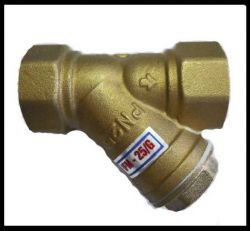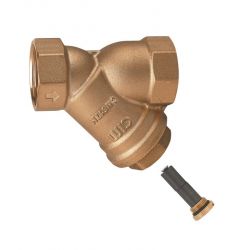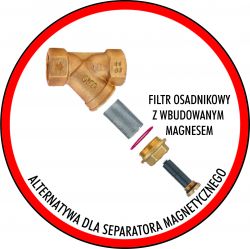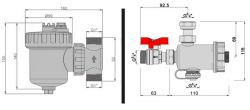In the instructions for the purchased Termet Ecocondens Gold stove, it is written that the manufacturer recommends using the filter as in the topic.
I asked a few fitters and service technicians, most replied to forgive themselves.
On the part of Termet, there was a suggestion that it is worth connecting it to the installation, because it has: a strong neodymium magnet, which catches metallic particles, the so-called magnetic sludge, and additionally, mechanical impurities using centrifugal force. Thus, it protects the PWM circulation pump, which currently costs about PLN 1000 and which also has a very strong magnet and collects impurities, which contributes to its damage and improper operation.
In some stores you can see how the filter works on specially prepared simplified models.
The problem is that:
- the cost of such a filter with connection valves is from about PLN 350 up (Caleffi, Ferdom, Fernox, Abbey)
- the housings are made of various materials and it is not known how they will behave after 10 years of contact with water, which changes the temperature cyclically
- the popularity is not visible on the Allegro, the sale is literally a few pieces
- require some space for mounting
- Is it possible to buy, for example, a cartridge or other components that break when disassembled or fallen in a few years?
I attach a picture:

While browsing the offers, I also noticed simpler brass sediment and oblique mesh filters, also magnetic, because they have a magnetic insert (a pile of ferrite magnets arranged coaxially on a brass ring mandrel, separated by spacers). Such a filter is called IFM costs about PLN 120 and on the outside it resembles a regular oblique mesh filter. Also in this case, there is no interest in, for example, Allegro. In one of the two large wholesalers, the seller did not know the technology .. :)
I enclose links to the manufacturers' websites (if they do not work for some time, they are clear enough that you can find them in google archives with after-visible words) and a photo:
http://www.infracorr.com.pl/wsparcie-technicz...42-prawidlowy-dobor-filtrow-magnetycznych-ifm
https://onninen.pl/pl-PL/filtr-magnetyczny-ifm-32-gwint-ifm32g-infracorr,HCG542
This type of filters can be mounted with the longitudinal axis vertically or horizontally, but the most important thing is that the strainer housing and the outlet point downwards.
I enclose a drawing and a quote from the DTR.


What do you say ? At the moment, I plan to install a cheaper option
I just can't understand why a regular O-ring was not used to seal it, but a fiber gasket, which "sticks" to the surface with time and it is difficult to remove / prepare the surface for a new one.
A heartfelt request not to tie in to threads unrelated to the topic and thus not diminish clarity. Thank you for your understanding.
I asked a few fitters and service technicians, most replied to forgive themselves.
On the part of Termet, there was a suggestion that it is worth connecting it to the installation, because it has: a strong neodymium magnet, which catches metallic particles, the so-called magnetic sludge, and additionally, mechanical impurities using centrifugal force. Thus, it protects the PWM circulation pump, which currently costs about PLN 1000 and which also has a very strong magnet and collects impurities, which contributes to its damage and improper operation.
In some stores you can see how the filter works on specially prepared simplified models.
The problem is that:
- the cost of such a filter with connection valves is from about PLN 350 up (Caleffi, Ferdom, Fernox, Abbey)
- the housings are made of various materials and it is not known how they will behave after 10 years of contact with water, which changes the temperature cyclically
- the popularity is not visible on the Allegro, the sale is literally a few pieces
- require some space for mounting
- Is it possible to buy, for example, a cartridge or other components that break when disassembled or fallen in a few years?
I attach a picture:

While browsing the offers, I also noticed simpler brass sediment and oblique mesh filters, also magnetic, because they have a magnetic insert (a pile of ferrite magnets arranged coaxially on a brass ring mandrel, separated by spacers). Such a filter is called IFM costs about PLN 120 and on the outside it resembles a regular oblique mesh filter. Also in this case, there is no interest in, for example, Allegro. In one of the two large wholesalers, the seller did not know the technology .. :)
I enclose links to the manufacturers' websites (if they do not work for some time, they are clear enough that you can find them in google archives with after-visible words) and a photo:
http://www.infracorr.com.pl/wsparcie-technicz...42-prawidlowy-dobor-filtrow-magnetycznych-ifm
https://onninen.pl/pl-PL/filtr-magnetyczny-ifm-32-gwint-ifm32g-infracorr,HCG542
This type of filters can be mounted with the longitudinal axis vertically or horizontally, but the most important thing is that the strainer housing and the outlet point downwards.
I enclose a drawing and a quote from the DTR.


What do you say ? At the moment, I plan to install a cheaper option
I just can't understand why a regular O-ring was not used to seal it, but a fiber gasket, which "sticks" to the surface with time and it is difficult to remove / prepare the surface for a new one.
A heartfelt request not to tie in to threads unrelated to the topic and thus not diminish clarity. Thank you for your understanding.







